Audience and Wealth, Part II
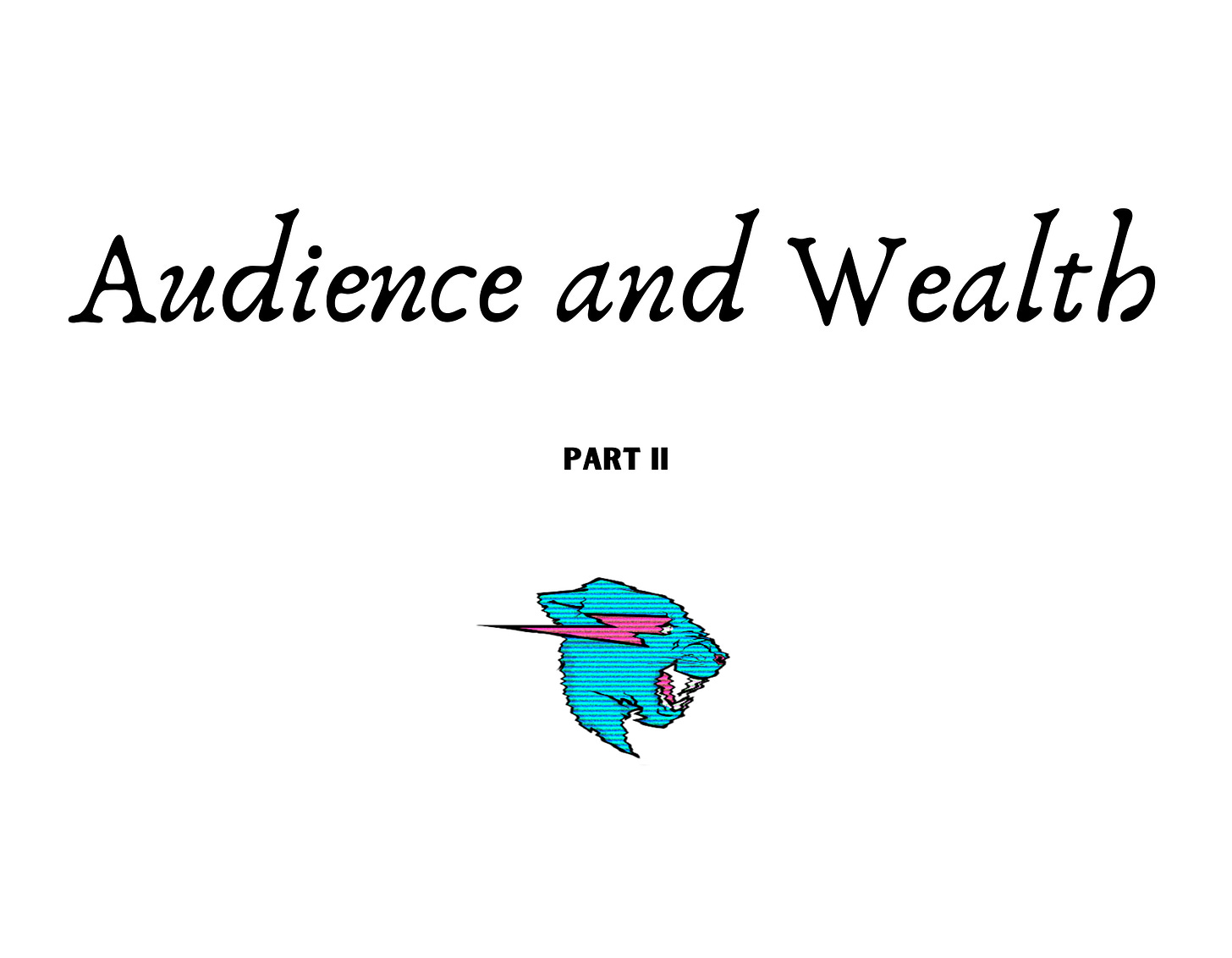
This is Part II in a series on Audience and Wealth. Part I focused on the problems creators solve for consumers and the business models they use to build wealth. You can read it here. Today, we'll close the series by discussing the following subjects:
The roles creators, audience, and advertisers play
Why creators should solve for co-creation, shared status, and shared wealth
The emergence of new roles and new models
Thank you for spending a few minutes of your day with me.
WHO IS THIS FOR?
Founders. The changing relationship between creators and their audiences presents opportunities for new businesses. I identify a few promising areas.
Investors. A recent report states there are 50 million creators worldwide, +2 million of which are professional. Changes in money movement among critical stakeholders will create new winners and increase demand for infrastructure.
Learners. The creator economy signals a broader shift: the movement of talent away from traditional employment and institutions. As you think about your place in the business ecosystem, it's worth understanding the relationships at play and how you might capitalize.
AUDIENCE AND WEALTH, PART II
In 2012, researchers at the University of Oregon sought to answer a philosophical question: how do the roles we play affect our behavior? How does our perceived identity determine our actions?
Their investigation focused on 128 members of the US Army that served as both medics and soldiers. Subjects answered a range of problem-solving questions involving life or death circumstances. Though they did not believe themselves to be under any influence, they were: subtle cues in the wording of questions primed participants to view themselves as either medic or soldier. Depending on which role they subconsciously adopted, participants made radically different decisions. When playing the role of a soldier, subjects were more likely to sacrifice one life for the good of the group, subscribing to a utilitarian approach. When prompted to view the world as a medic, subjects were less willing to put a price on an individual's life.
The same pattern held when researchers studied individuals outside the theatre of war. Employees that served as both engineers and managers were asked to respond to business problems focused on entering a new market. When primed to think like engineers, just 13% believed it was appropriate to resort to illegal tactics to win share in a new market. When acting as managers, 50% considered it prudent.
The experiments' upshot makes intuitive sense but is nevertheless profound: the role we believe we are playing defines our actions in a particular circumstance.
Just as such a concept applies to our professional lives, the formal positions we fill, so too is it visible in less-defined relationships. In the relationship between creators, audiences, and advertisers, each party finds themselves beholden to expectation, acting according to the role prescribed.
New business models are slowly changing these boundaries. In this revised world, audience members act as co-creators, advertisers escalate content with money, and creators direct attention to others. These reconfigurations enable new types of content and deeper intimacy between creators and their community.
Stakeholders and Currencies of Contribution
Though we may not always realize it, every piece of content involves a series of transactions, a string of exchanges.
Depending on who we are, and the model used, we pay with some combination of four currencies: effort, attention, money, or ownership. Below, we make sense of this concept within the framework of the three wealth-building models identified last week.
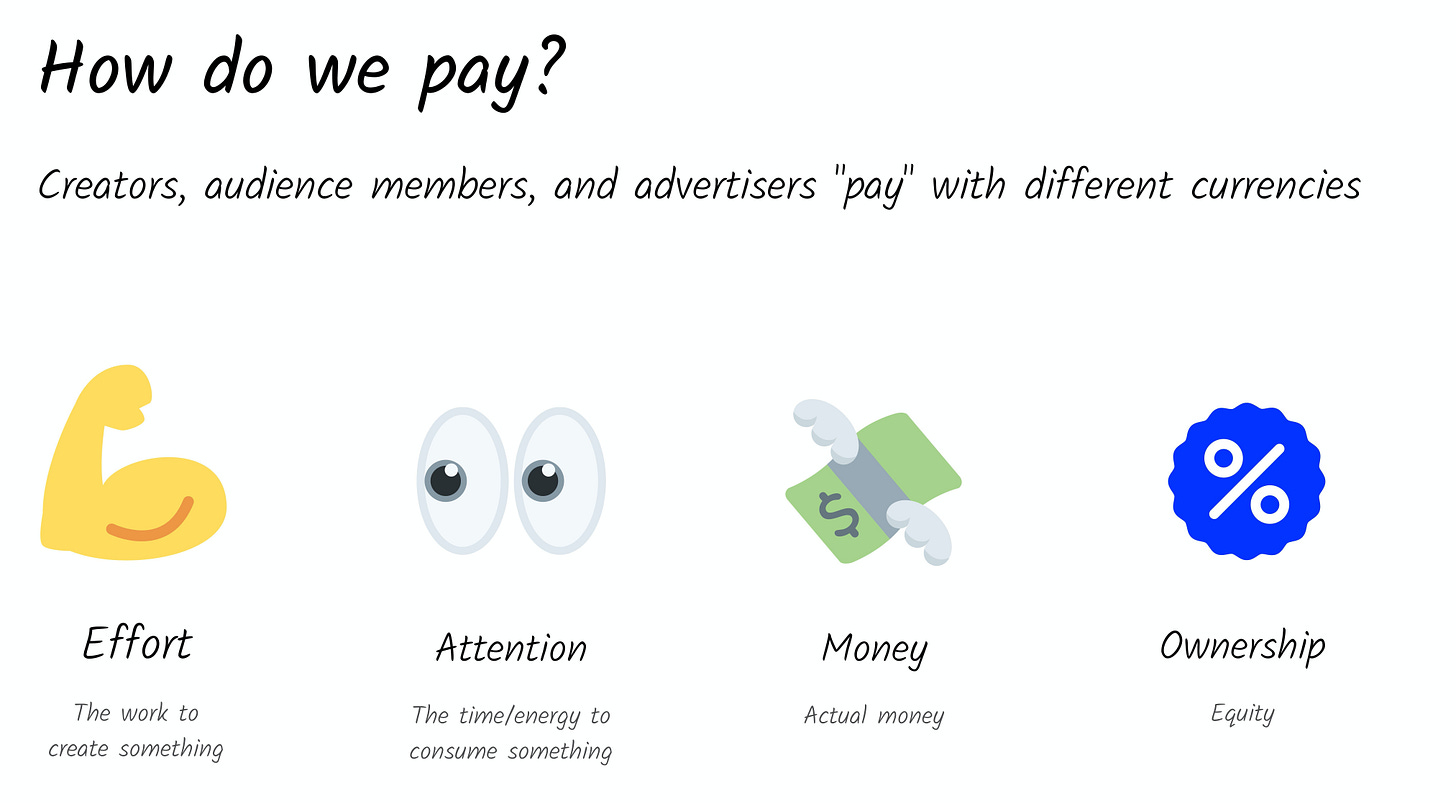
Promote
There are three stakeholders in a promotion-based monetization model: creators, audience members, and advertisers. Each party pays with a different currency.
Creators pay with effort. They put in the work to create a product in the hopes the audience consumes and engages with it. Audience members, on the other side of this interaction, pay for this effort with attention.
This is a symbiotic relationship, up to a point. Each party benefits, though no money is earned. Advertisers solve that problem. They buy the attention accumulated by the creator and pay with money.
Though this process occurs countless times a day, it is still a nifty bit of magic: three parties enter temporary communion, paying in tangible and intangible currencies.
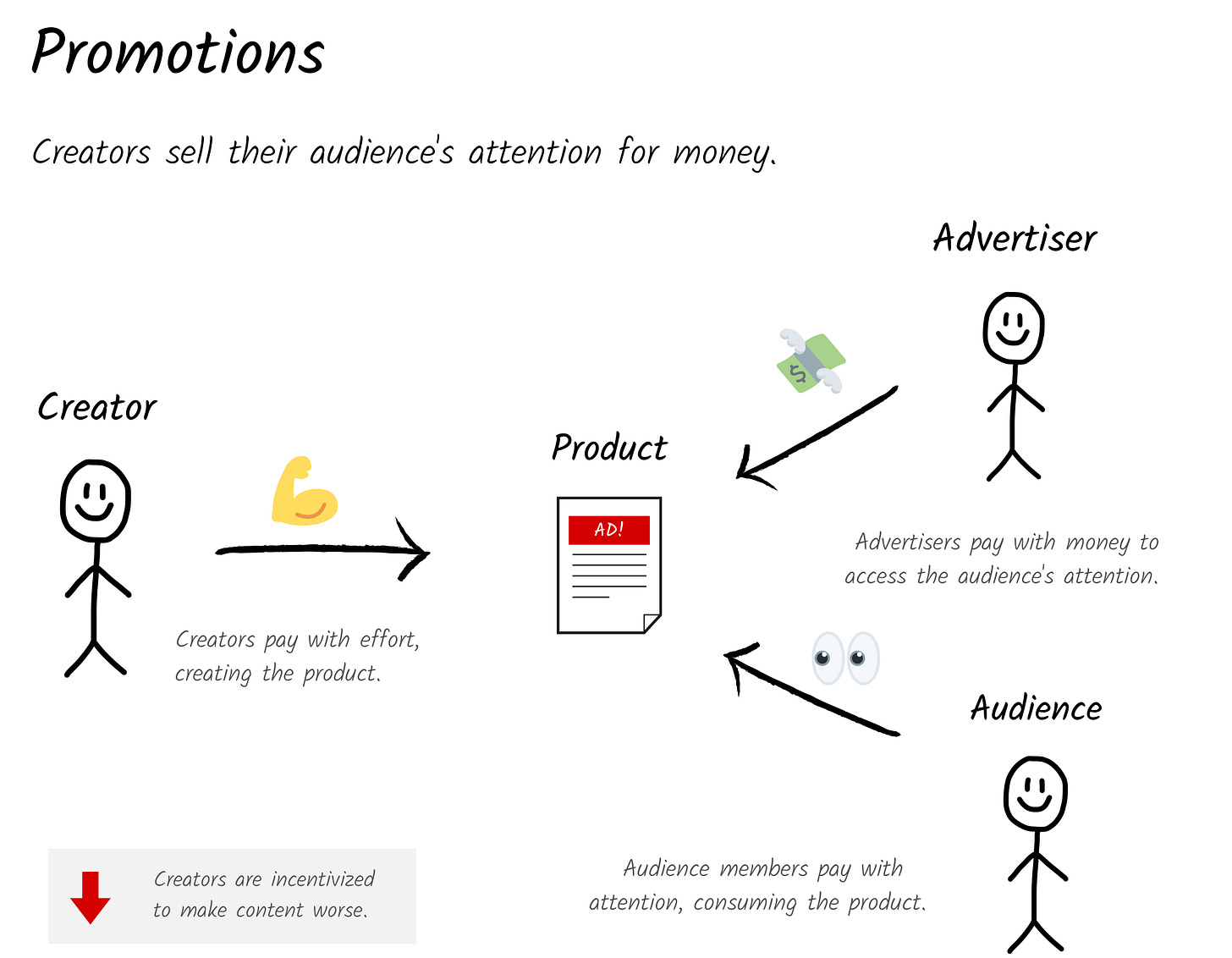
There are both advantages and disadvantages to this model. Audience members may prefer to pay with attention, either because they cannot pay with money, or because the perceived monetary value of the content consumed is higher than the cost of attention.
There are significant downsides. Whereas some models incentivize the creator to improve product quality, a promotional model does the reverse. Creators are incented to sell as much audience attention as possible without losing trust, while audience members want to benefit from creators' efforts with as little misdirected attention as possible.
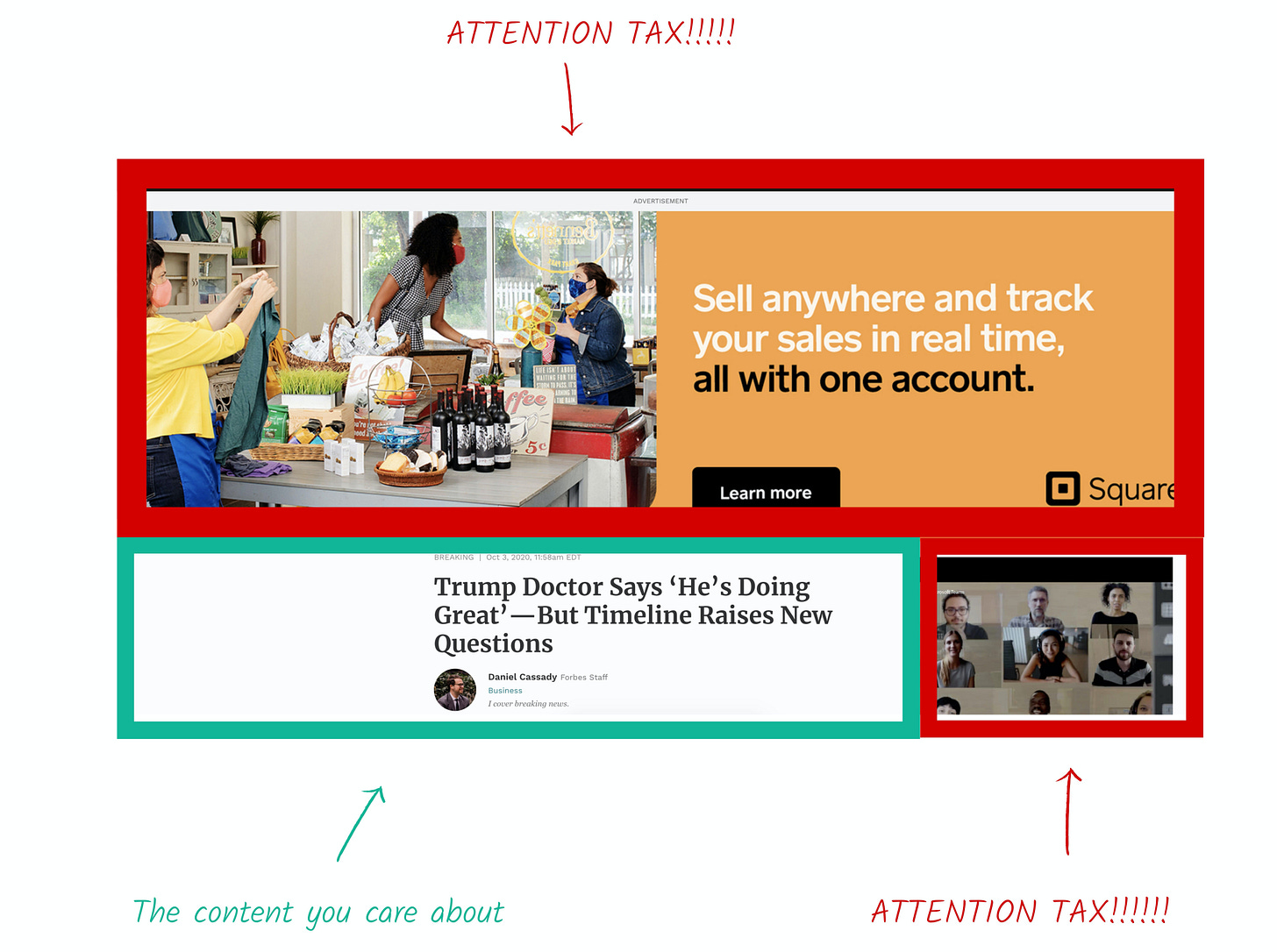
It also creates tension: creators should improve their product to build an audience, then degrade it by adding advertisements. Every ad is a tax of attention levied on the audience, misdirected towards a cause the audience has not consented to. The less relevant the ad, the greater the tax. Within this model, creators and audiences find their kinship interrupted.
Sell
Creators remove the need for advertisers by monetizing from audience members directly. Creators pay with effort while the audience pays with money first, attention second. Functionally, that means, ceteris paribus, a creator prefers a subscriber that pays but never consumes to one that consumes but never pays. Attention is important to the extent that it acts as a lubricant for conversion and retention — creators that have an attentive audience will find it easier to increase their following and retain members.
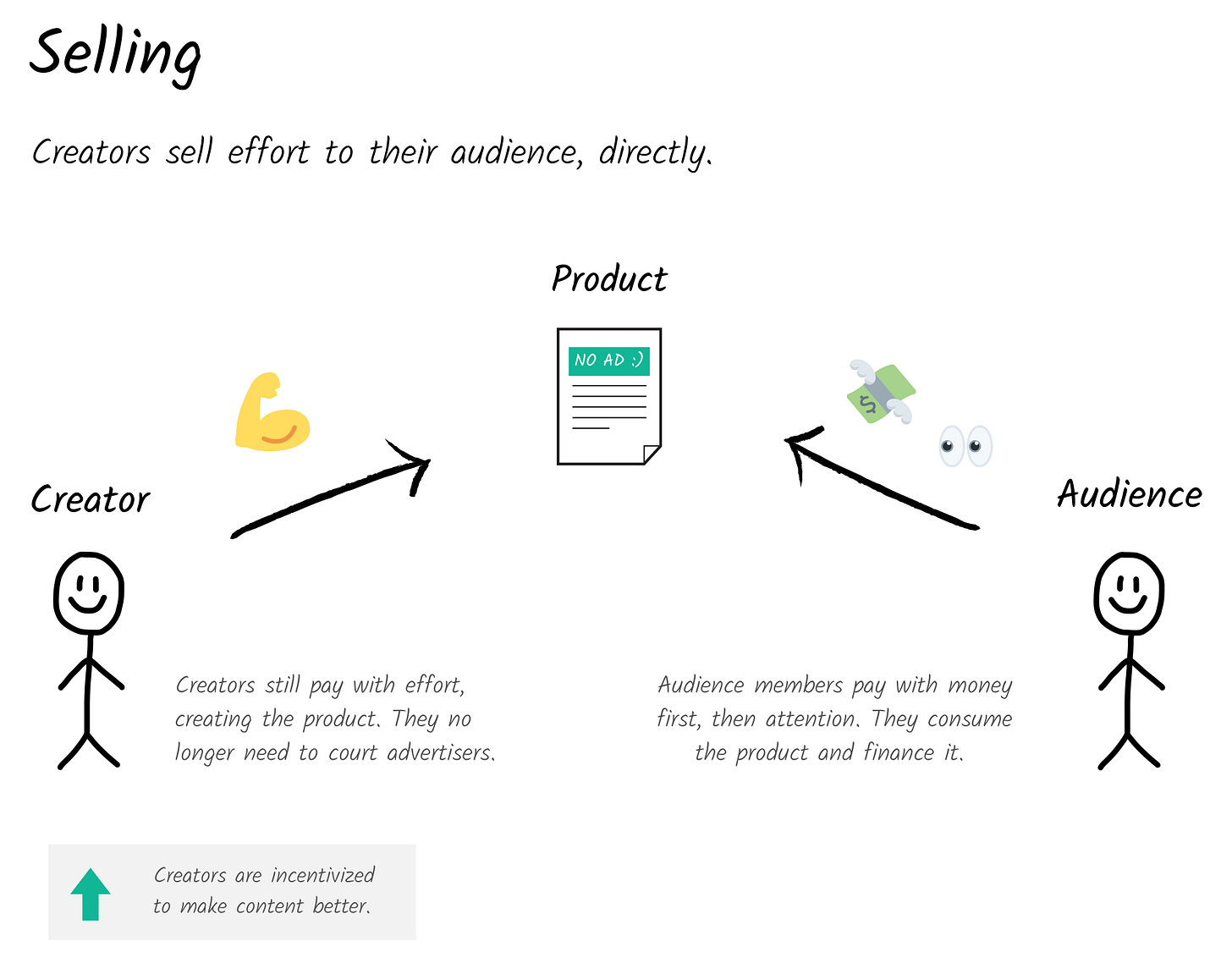
Again, there are positives and negatives to the model. Critically, this model incentivizes the creator to improve their content (or expand operations). The audience is paying the creator for precisely this effort. The downside is that potential audience members are left out — what they might have been happy to "buy" with attention can be out of reach or undesirable when money is required.
Invest
Creators that build wealth by investing in startups add a stakeholder to the mix: the company’s founder. This model can be leveraged in conjunction with those listed above, or independently. Isolated, creators buy ownership from founders with money and audience attention. The agreement they make is that they will expose the founder to their audience in addition to the cash provided (a commodity).
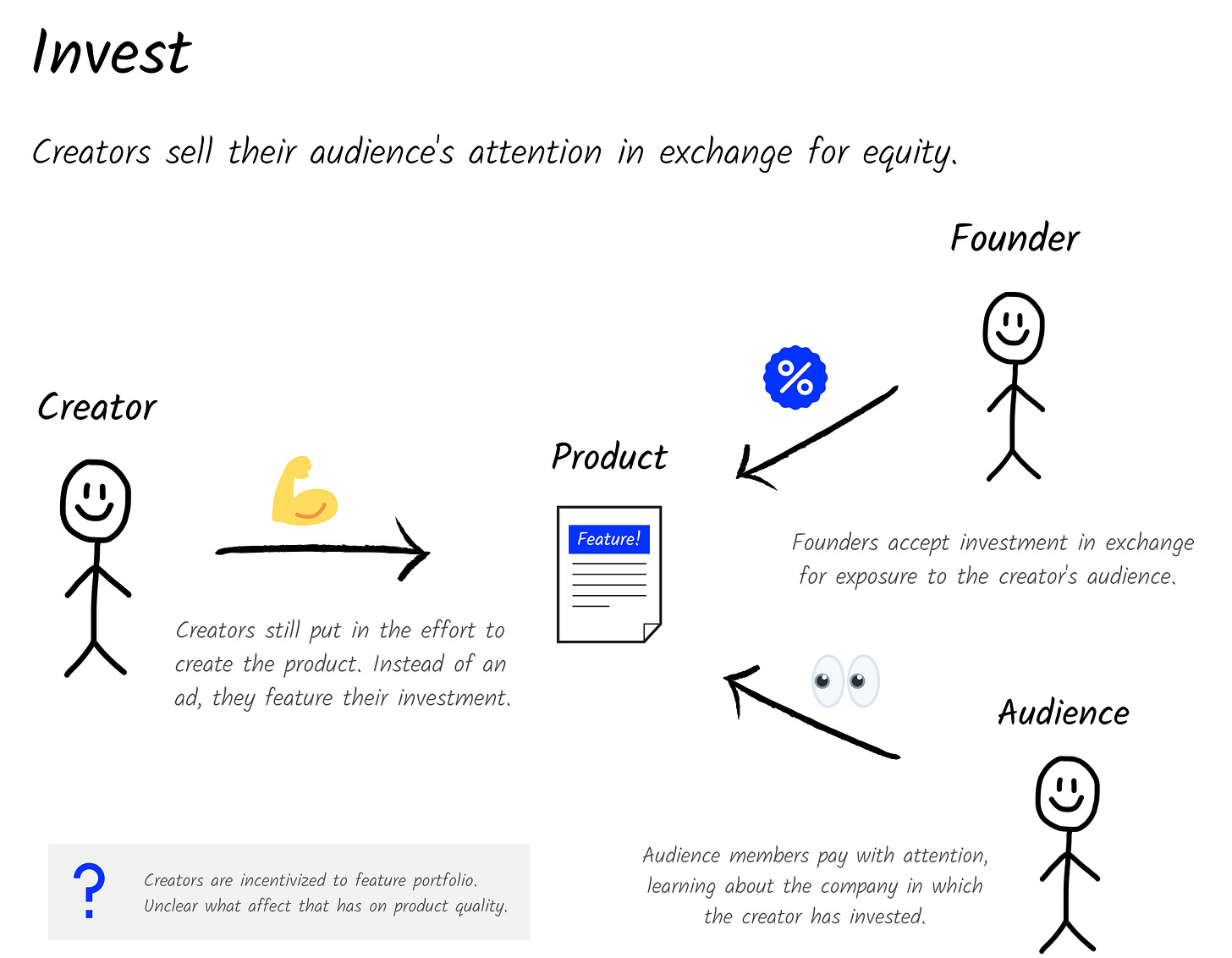
Depending on the creator's focus, this kind of promotion can be natural and, as such, not corrosive to the content. If you subscribe to a venture capitalist's newsletter, you're likely interested to learn about the company they just backed. The downside to this approach is that it's limited, restricted to tech and venture capital for the time being. Additionally, it's only viable for creators able to sustain themselves some other way, either through traditional promotions, product sales, or an ancillary salary.
Solving for Sharing
Before wondering how these models can be improved, we need to ask: what are we trying to achieve?
What incentives do we want to magnify?
I believe the most successful creators will figure out how to share, splitting the "currencies" mentioned above. Effort, attention, money, and ownership can all be distributed within an audience. For the audience, distribution creates opportunities to learn, gain status, earn money, and accumulate equity. For creators, it deepens intimacy with an audience, aligns interests, and solves scale.
Sharing effort: co-creation
As physicist Richard Feynmann noted, "If you want to master something, teach it."
Audiences are motivated by the ability to learn, with knowledge products like courses and newsletters drawing on this desire to grow a following.
Creators can better serve this desire by sharing the effort required to bring a product to life. For example, rather than creating a new course on analyzing SaaS businesses, I could solicit interest from the community, selecting applicants to help out. In the process, audience members become "contributors," learning and applying new skills.
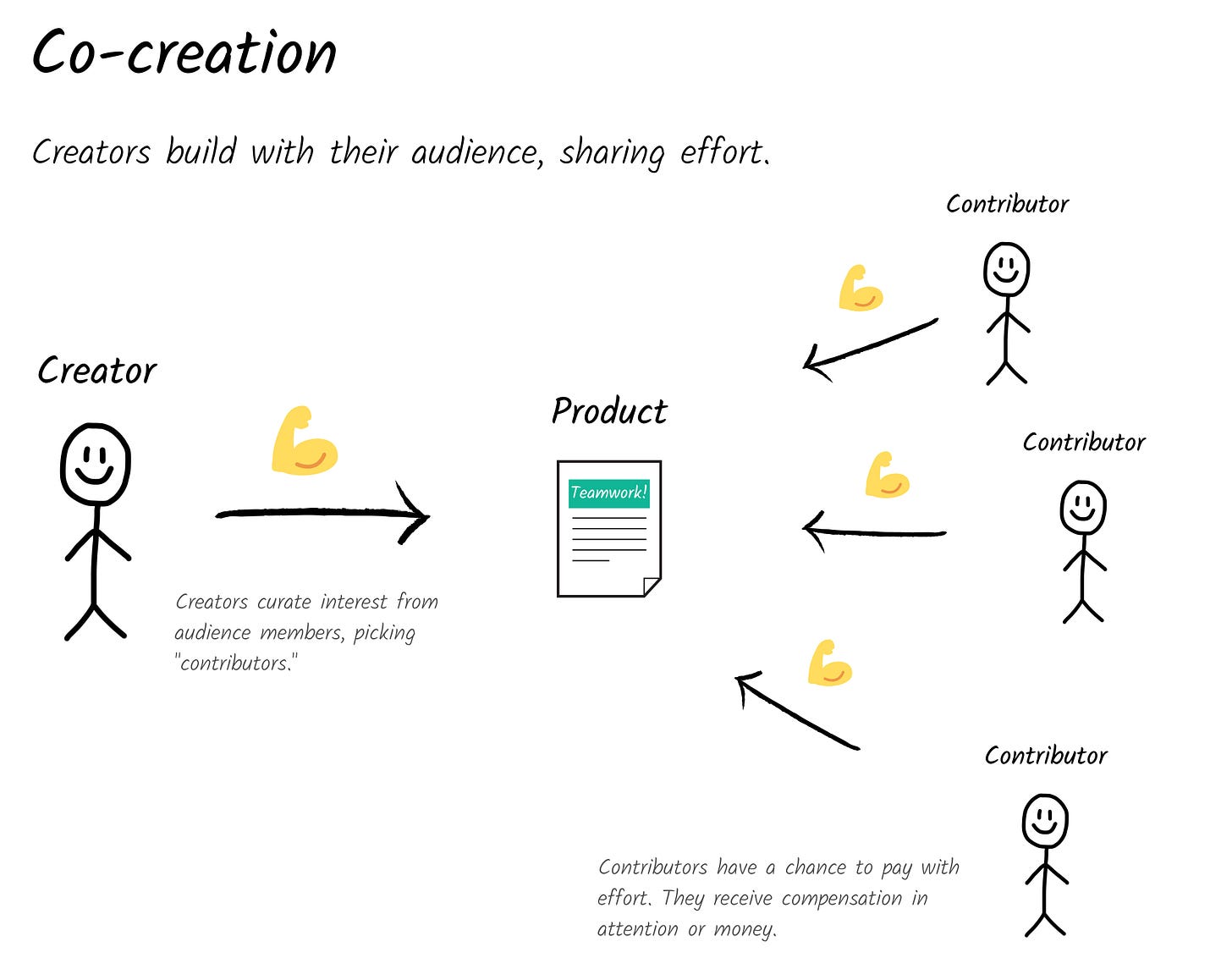
The problem is curation — it may be difficult to grasp an individual's abilities and commitment without considerable assessment time. But as creators get to know their audience better, this issue should be mitigated. The upside is significant; creators can better scale their operation, sharing effort while forging closer ties with their audience.
Sharing attention: community status
We all seek a sense of belonging. It's what inspires our desire to seek out groups of like-minded people. Once that fit is established, there's status in being a community leader. The most direct example here is Reddit: the moderator of a particular subreddit holds status to those engaged in the community. Even a contributor that writes a popular comment benefits — receiving upvotes and other awards for their involvement.
This form of anointment is not common in creator circles. There are no awards for listening to the Masters of Scale podcast every week; no accolades for reading Stratechery.
Returning to the example above, the creator could (and should) highlight those contributors that worked to create the product or engage with the community on a regular basis. By doing so, they share attention. Within the confines of a particular community, that attention can grant status.
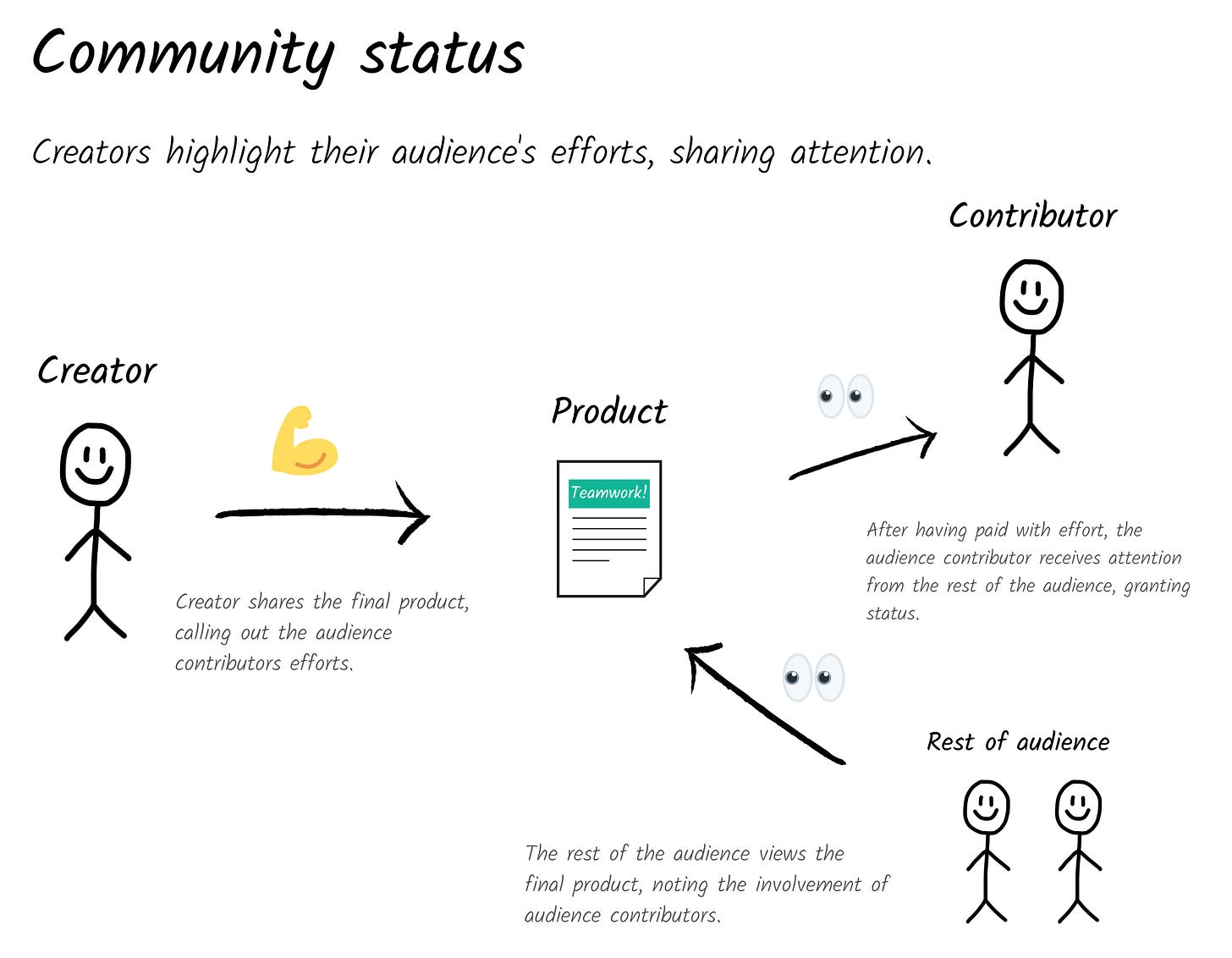
Creators that elevate supporters by sharing attention will incentivize engagement. In the long-run, that improves the experience for members and increases the quality of the community.
Sharing wealth: syndicates and splitting revenue
Finally, creators can share wealth with their community in the form of money and ownership.
Again, let us frame the conversation within the example course. Contributors have given their effort and been rewarded with attention, so far. Should creators not share money with them, too? And what about those not selected to contribute, but still active in sharing and promoting the work?
With better infrastructure, creators may be able to reward and incentivize their community financially. If focused on the upside — giving 20% of future earnings back to the audience after a certain threshold is met, for example — creators would align incentives without upfront costs.
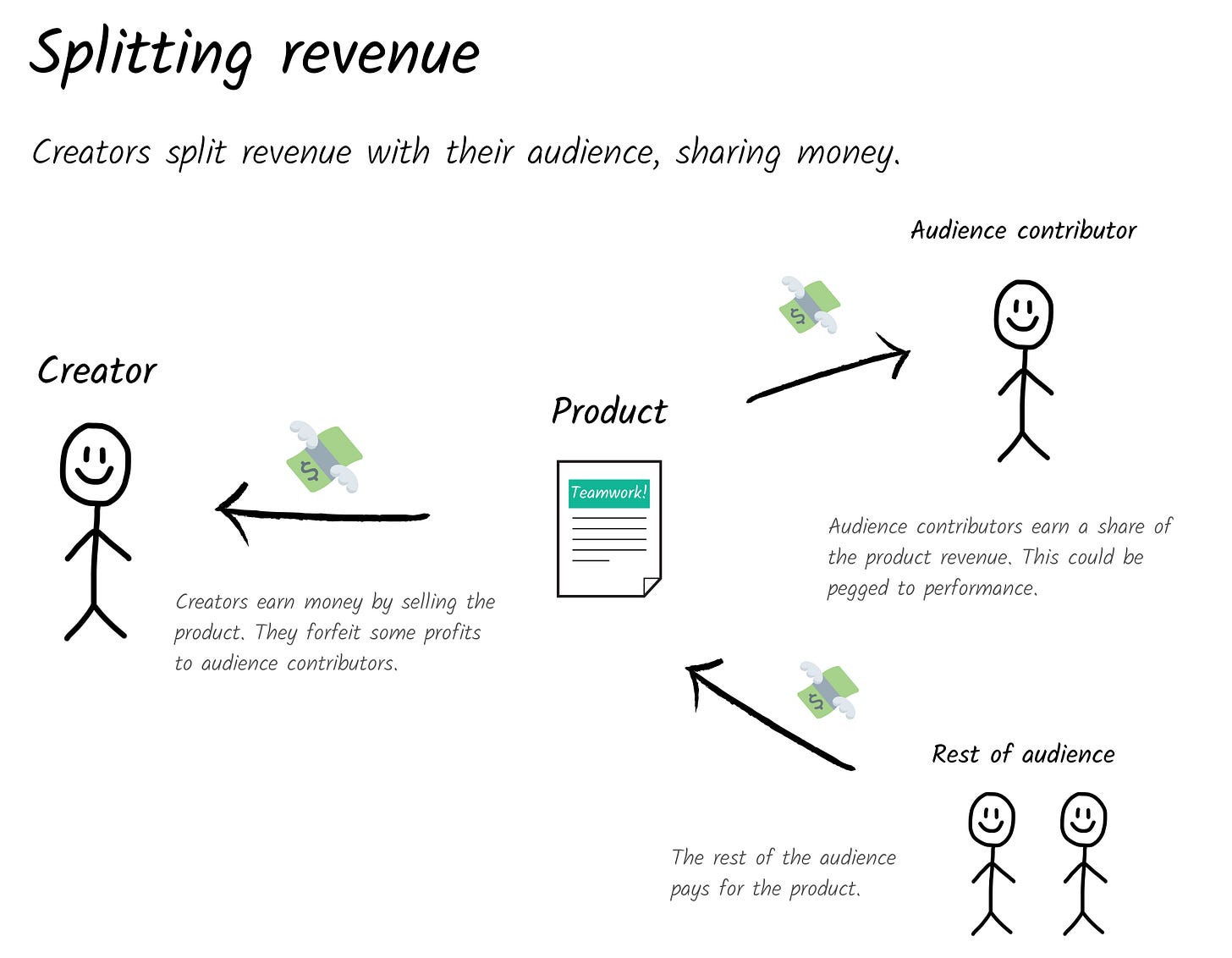
Similarly, creators can leverage a syndicate to share ownership with their audience. While a direct investment means that only the creator has the chance to buy equity, syndicates create a pooled fund open to any accredited investor. With this structure, creators allow their audience to put their money to work alongside them. Because of private market investing's exclusive nature, this could serve as a powerful incentive: encouraging new members to join and others to stay for the long-term.
New Roles, New Models
With these motivations in mind, what models might we see emerge? And what companies should be built to serve them?
Advertisers as content escalators
Halfway through his recent video, "Would You Rather Have a Giant Diamond or $100,000?" MrBeast asks one of his participants if they'd like to play a game. To win, the participants need to pick up a "dragon's egg" and smash it over their head. If the egg contains confetti, they win $1,000. Dragon City, a mobile game, sponsors the video.
During the 13 minute clip, viewed over 22 million times, MrBeast gives thousands of dollars to subscribers to reward their successful participation in various games.
The genius of the model is in its reconfiguration of the relationship between creator, audience, and advertiser. Rather than being a tax on the audience's attention, an intrusion on what the audience wants to see, the advertiser is central to the content itself. The money they provide becomes the content and escalates it. Without the budget of Dragon City, MrBeast couldn't finance such lavish rewards, and as a result, wouldn't attract as large a viewership. It's a virtuous cycle, with more audience driving more ad dollars, facilitating crazier and crazier giveaways.
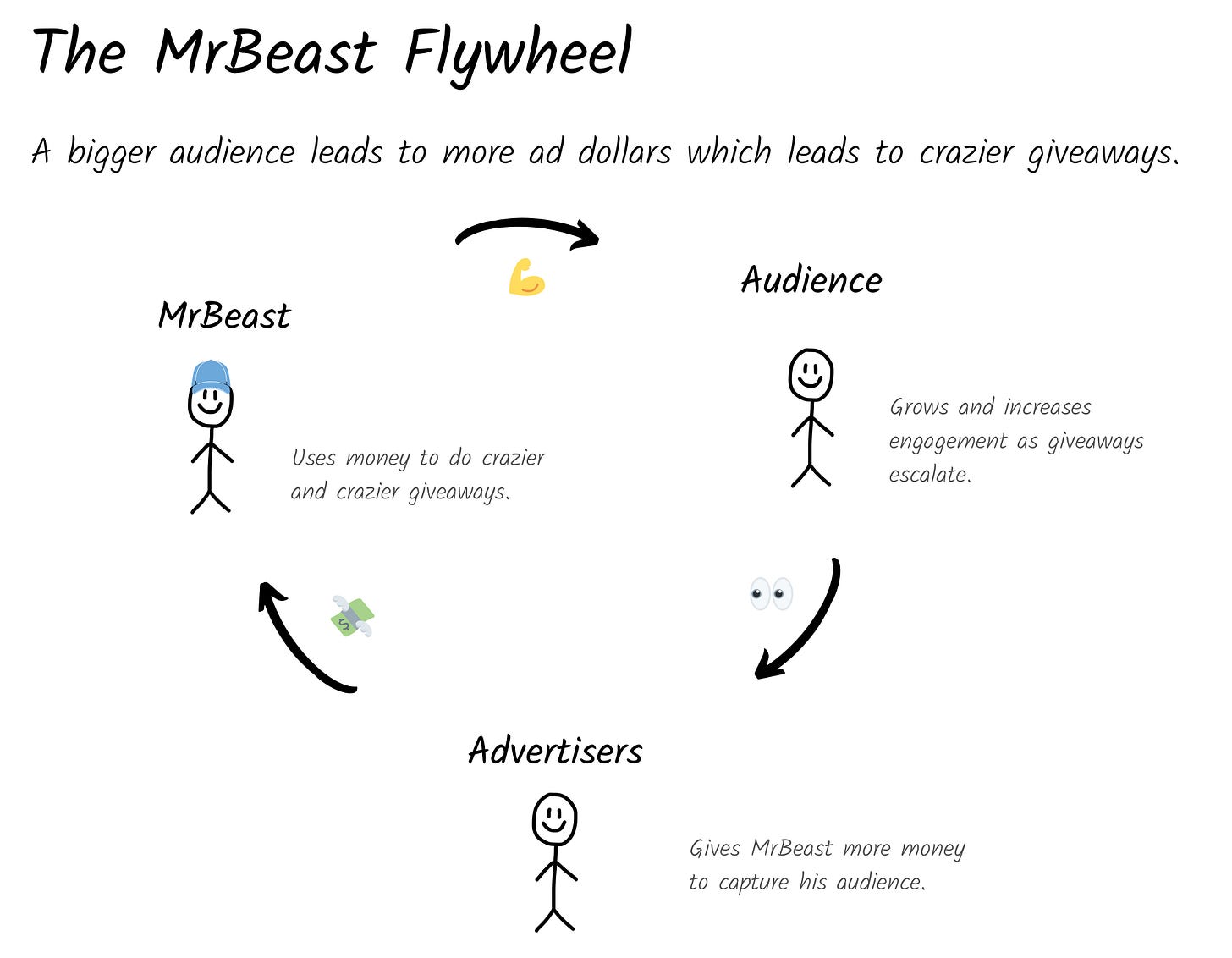
Just as importantly, MrBeast shares what he's earned: audience members participate in the video's creation, earn status through that inclusion, and take home real money.
What does this model look like applied to different mediums? How could a podcaster or newsletter writer do something similar?
An example concept: The "Generalist Genius Grant."
Members of the community could submit applications, pitch in front of an audience, and win a $5-20K stipend to kick off a project. It might look like a home-spun version of Shark Tank (but without taking equity) or closer to Pioneer, open to researchers and artists, as well as founders. The money itself would come from sponsors — a startup bank, or payments service, for example. In time, as the audience grew and the format became more persuasive, larger sponsorships could be secured, raising the stakes.
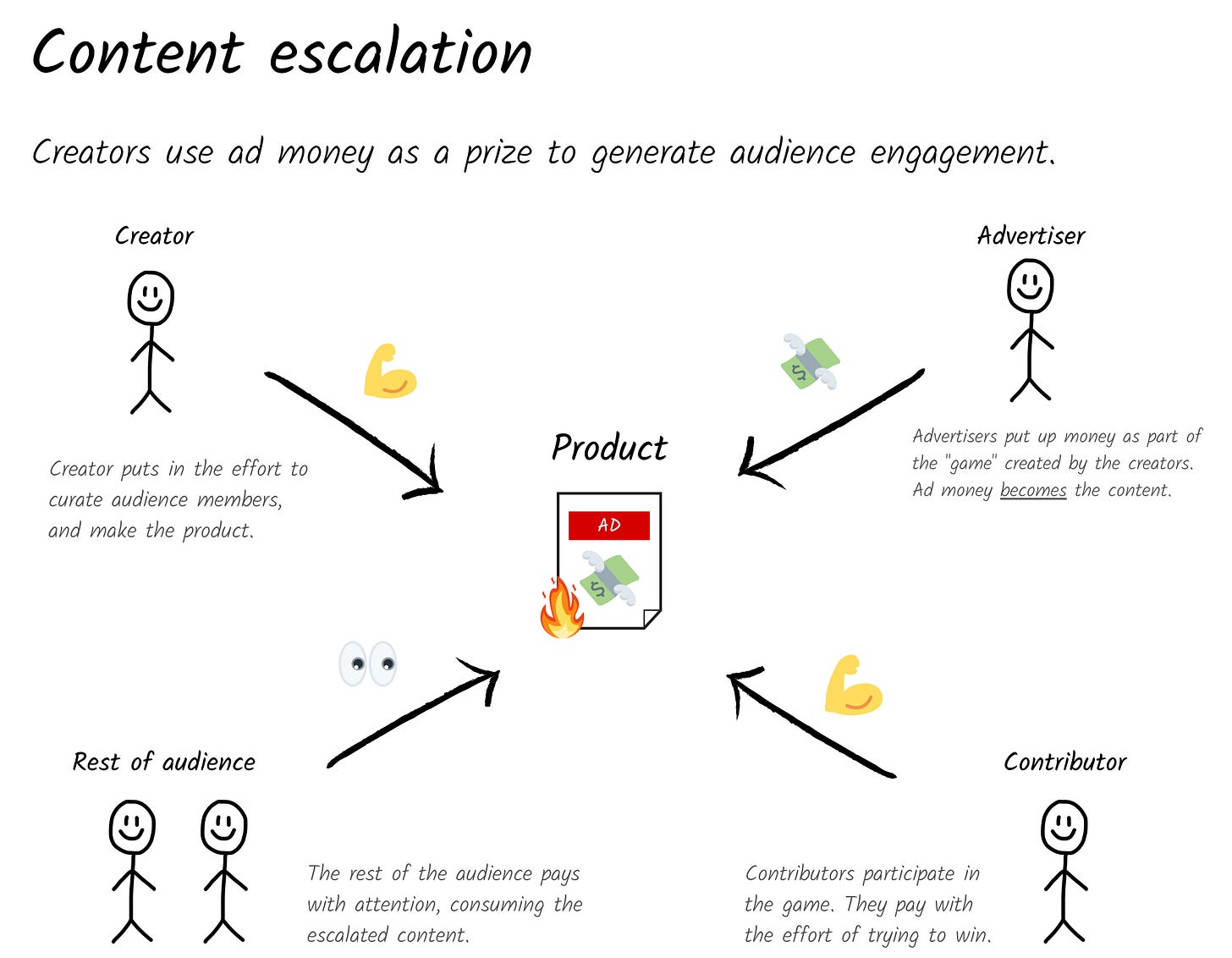
Streamlining the process of receiving applicants and tracking progress may represent an opportunity for startups. As alluded to above, Pioneer runs a tournament-style contest, designed to help founders and creators find product-market fit. What would "Pioneer-as-a-Service" look like, embeddable as a software stack and playbook across communities?
Decentralized syndicates
The nagging question for any new party ponying up to the venture poker table is this: why you? Of all the tech icons and storied firms, how come you're getting a chance to invest?
More than most, syndicates suffer from adverse selection. Because they allow any accredited investor to participate, founders receive less status in taking money from them. That can be counterbalanced by the syndicate head having a personal relationship with a founder or an established reputation themselves, but it is an uphill battle. Moreover, because syndicates are often run as side-projects, syndicates heads may add much value to the founders they back.
By banding together, creators have the chance to change this, forming effective, high-signal syndicates. In doing so, they solve a critical issue for startups: distribution. By aggregating audiences, they can serve new companies to a large pool of consumers and businesses.
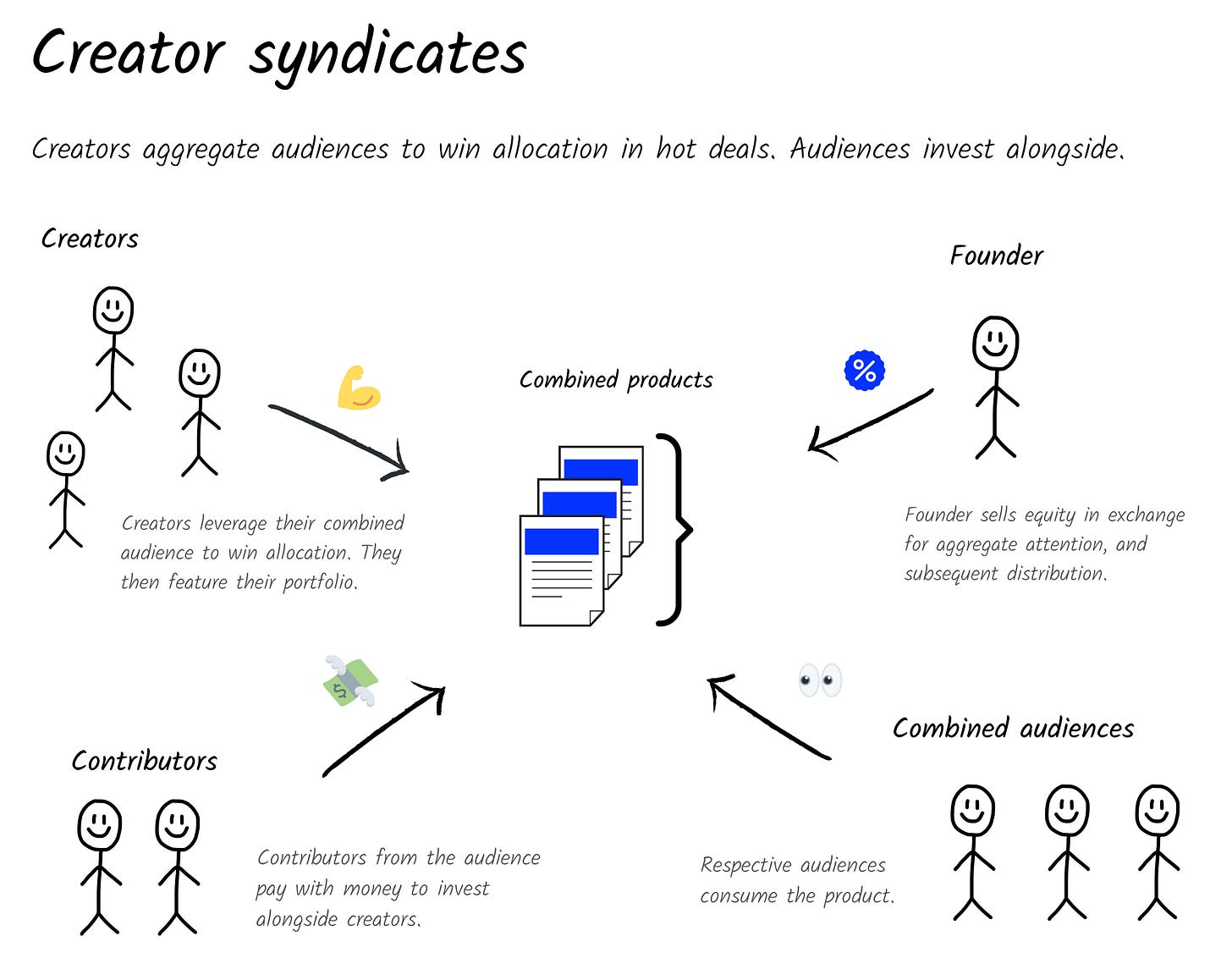
Another illustrative hypothetical: a writer’s syndicate.
In exchange for accepting investment from your favorite tech newsletter creators, founders would get access to writers' audiences. Meanwhile, audience members would have the opportunity to invest alongside a trusted source (the creator) with the risk of adverse selection mitigated. Just as traditional venture firms secure allocation by solving a specific problem — think Signalfire for recruiting, or Bling Capital for reaching product/market fit — "Letter Capital" could win deals by solving distribution and PR.
Engagement as payment
For a couple of months last summer, every time I got into a cab, I opened my phone and fired up an app. Tennis Clash is exactly what it sounds like: a candy-colored tennis competition. While the game is undoubtedly fun, part of the reason I found myself logging in so regularly was to win awards. By maintaining a certain frequency of play, I earned special rackets, in-game currency, and access to new levels.
This gambit is common in gaming — to keep players coming back you incentivize them. Rather than asking them to pay for new features with money, games often ask them to do so with effort, manifested by engagement. The same principles should be applied to the creator economy.
As it stands, there’s no comprehensive tools that allow writers, podcasters, and streamers to identify and reward their most loyal fans.
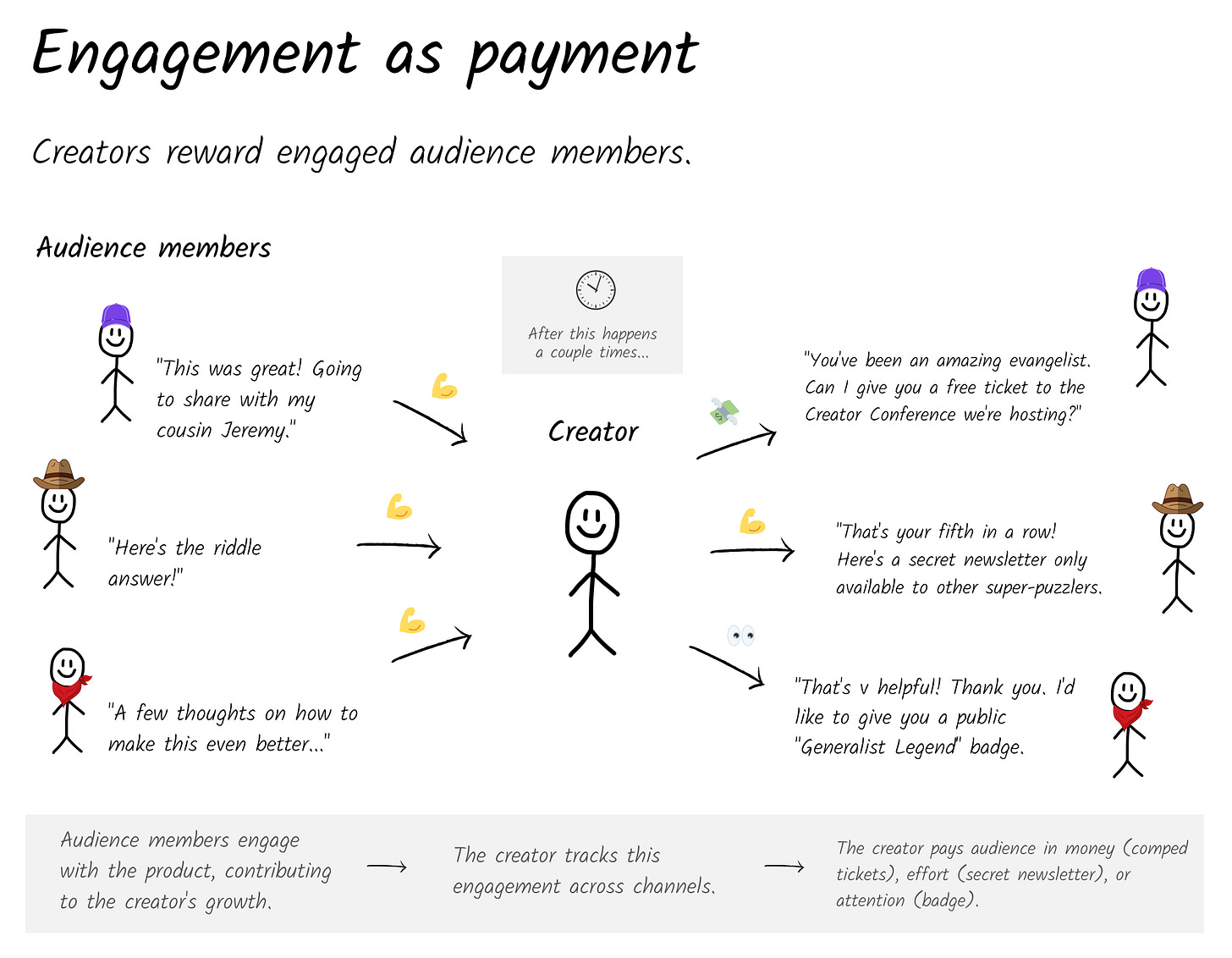
What would that tool look like for The Generalist? I can imagine a platform that aggregates interactions across platforms (pulling data from ConvertKit, Substack, Twitter, Stream, Linkedin, Medium, and Telegram) and extracts actionable insights. Which readers respond every week with a thoughtful comment? Which riddler has gotten the right answer five weeks in a row? Who is the IPO-aficionado that's attended every S-1 Club event?
For these scenarios and many others, I would love to recognize and reward the individuals in question. That might take the form of sharing extra content I think they'd like, organizing a private event, helping them with a writing project, or gifting a badge or award visible within the community, a sign of appreciation.
Again, this is an opportunity. While existing platforms track audience members as paying or non-paying entities, there's no system (that I've found, at least) that classifies members based on effort and engagement. That could prove a valuable tool that recalibrates the creator-audience relationship.
~
"We are what we have been told about ourselves. We are the sum of the messages we have received. The true messages. The false messages."
So goes a line of dialogue in post-modernist Donald Barthelme's novel Snow White.
Our behavior depends on whether we believe ourselves to be a medic or soldier, engineer or manager, creator or audience member. While those roles have meant that traditionally creators pay with effort and audiences pay with attention or money, new models allow for mediation. Boundaries are movable, lines are blurring.
In this period of dynamism, this dance of frameworks, creators must decide what they want to achieve. Those that learn to share — to distribute effort, attention, money, and ownership — have the chance to build deeper relationships with their audience, and eventually subvert the concept of an audience in and of itself. In the end, the goal is not to be one thing or another, to be some half of a circle, light or dark. It is to be in the arena, to bring others in, and together, to build something greater than ourselves.
OTHER NEWS
Erik Torenberg: Hustle and Flow
This profile of the On Deck founder touches on his love for freestyle rap, being mentored by Keith Rabois and Tyler Cowen, and missing out on investing in lockdown hit, Masterclass. I particularly enjoyed hearing Erik's thoughts on networks, non-violent communication, and venture capital as a product.
Read more about Erik Torenberg »
Upcoming Event: Scarcity and Abundance in Tech
On November 1 at 2 pm ET, Eugene Wei, Alex Danco, Julie Young, Julian Lehr and I are going to talk about applications of scarcity and abundance in tech. I recently wrote about the subject in "Scarcity as an API" and thought it would be fun to continue the conversation. The collected panelists are some of my very favorite writers and thinkers. I'd love to have you join.
PUZZLER
As always, clues given to those curious enough to message. All efforts welcomed, no matter how speculative.
If you throw me out the window, You'll leave a grieving wife. But leave me in the middle of the door, And you might just save a life. What am I?
Brisk as an autumn wind, Chelsea H stormed to the win this week. She was followed minutes later by Jeb B, with Mark V, Kaitlyn R, Monica V, Aisling S, Nate S, Keith T, Marquis B, Nick B, and Chris F shortly behind. All provided the correct answer to our previous puzzler.
I might come through your window, And I’m often at the bar. Sometimes I’m used to send you, To fight in lands afar.
The answer? A draft. Other clever answers included "a seabreeze"(Rob M), "a bird" (Daniel A), and "water" (Ibukun A and NMT). Well done to all that tried their hand.
Thank you very much for reading. If you've enjoyed this mini-series, I'd love to know. And if you think there's someone in your life that might be glad to know about the creator movement and its various dynamics, I'd be grateful if you'd share the word.
To you all,
Mario


